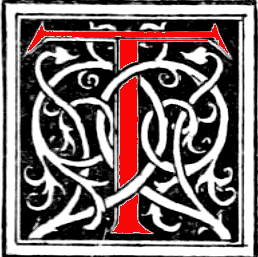
he revival of Arthurian themes in Victorian times was strongly associated with Tennyson's early works, none more so than with his "Sir Galahad," with its intimate first-person narrator, whose "strength is as the strength of ten,/ Because my heart is pure." Other qualities of the Knight, as related in Tennyson's 1842 Poems, Vol. II, also work as a succinct partial portrait of the aspiring young Christ Church poet who would soon become better known as Lewis Carroll: "… Me mightier transports move and thrill; / So keep I fair thro' faith and prayer / A virgin heart in work and will." With Tennyson's subsequent 1859 volume Idylls of The King, attention had rightly shifted to the true progenitor, the legendary King Arthur himself. This work was dedicated to another Arthur, Tennyson's dearest friend from Cambridge student days, Arthur Henry Hallam, just as the new Poet Laureate also dedicated - "I dedicate, I consecrate with tears" - his long elegiac In Memoriam to him: "Fair ship, that from the Italian shore / Sailest the placid ocean-plains / With my lost Arthur's loved remains, / Spread thy full wings, and waft him o'er" (IX:1). Carroll and his several sisters were much impressed and involved in 1862, collaborating with each other to prepare a studious and almost reverentially thorough index of Tennyson's poem.
Shortly afterwards, when Queen Victoria lost her own beloved consort Albert, her Poet Laureate was quick to provide a further appropriately dedicatory edition of the Idylls, included in which was his eulogy to the departed Prince. Read by "all England," certain of its valedictory lines could arguably link the present trifecta of Arthur-Tennyson-Carroll: "…Not making his high perch the lawless place / Of wing'd ambitions …but through all this tract of years / Wearing the white flower of a blameless life, …" ("The White Flower of A Blameless Life," Dedication. Idylls of The King, 1862). A more obvious parallel would appear in Lewis Carroll's prefatory poem of 1871 at the close of his celebrated "Alice Period": the endlessly intriguing stanzas of "Jabberwocky" from Carroll's Through The Looking Glass. This parallel is brought out in Sir John Tenniel's accompanying illustration, with the valiant young hero wielding his "vorpal sword" (and pen) to slay the "manxome foe" of all evils. The early Pre-Raphaelites, and especially Dante Gabriel Rossetti who was much admired by Carroll in these early years, were also instrumental in visually enriching Victorian and our own appreciation of Arthurian themes and materials.

A diminutive Arthurian figure fights off the Jabberwocky in the lower right-hand corner of Tenniel's illustration of the nonsense poem.
The name Arthur had earlier burned itself into Lewis Carroll's being in 1863, during the high point of his personal relationship with the young Liddell sisters of Christ Church Oxford. Their newly-born young brother was taken suddenly ill and was hastily baptised with the names of the godparents, including Arthur after Arthur Penrhyn Stanley of Christ Church and Dean of Westminster Abbey. On Tuesday 26 May "came the melancholic news" of the infant's illness, and Carroll spent the morning walking the three young girls - Alice, Lorina and Edith - around Christ Church Meadow, with all present "grave and nearly silent." Two days later the baby was dead (Diaries 4: 145, 200-1).
Some time later, during the 1880s and his more contented Eastbourne Years, Carroll came to choose the name of his new novel's hero, the eventual consort to his heroine, Lady Muriel. Not unnaturally, in view of his immersion in such material, he selected the name of Arthur. So it was that in Chapter Two of Sylvie and Bruno in late 1889 - in the opening pages of this "above ground" but still disguised Victorian social romance - the character Dr. Arthur Forester makes his timely appearance. A medical man, reflecting Carroll's own hidden aspiration as shown by his various interests in homeopathic remedies, his extensive medical library and so on, this Arthur is endowed with both intellect and humour. He discusses deep religious topics such as Sin, and from a safe literary distance is allowed to quote Carroll's beloved Tennyson on such romantic themes as that expressed in the relationship of Enid and Geraint: "To stoop and kiss the tender little thumb / That crossed the platter as she laid it down" (Idylls of The King). According to his contemporary biographer Stephen Gwynn, that work of Tennyson's had been received by all England "with a tumult of acclaim" (12).
The two-volume children's novel that Carroll wrote later in life is also suitably replete with high Tennysonian themes and citations, with some thirty instances being identified, discussed and indexed in a recent publication (see Dyer, 2016). Carroll's deep fascination with Arthurian legend was also shown in his wider travels: when he visited Edinburgh in 1857 and 1871 he would make it a point to climb the prominent feature known as "Arthur's Seat" (Diaries 3: 97; 6: 181).
Links to related material
- Lewis Carroll and Alfred Lord Tennyson. A Detailed Chronology, 1832-1898. Part Five: Final Glances, 1889-1898
- Review of The Oxford Handbook of Victorian Medievalism, edited by Joanne Parker and Corinna Wagner (2020)
Bibliography
Carroll, Lewis. Lewis Carroll's Diaries. The Private Journal of Charles Lutwidge Dodgson, Ed. Edward Wakeling. Vols. 1, 4 & 8. England: Lewis Carroll Society, 1993, 1997 & 2004.
_____. Sylvie and Bruno
Sylvie and Bruno Concluded
_____. Three Sunsets and Other Poems. London & New York, Macmillan. 1898.
Dyer, Ray. Lewis Carroll's Sylvie and Bruno With Sylvie and Bruno Concluded. Scholar's Annotated Edition. Leicester: Troubador Books, 2015.
_____. Lady Muriel. Lewis Carroll's Hidden Romance. Scholar's Annotated Edition. Leicester: Troubador Books, 2016.
Gwynn, Stephen. Tennyson: A Critical Study. London: Blackie & Son, 1899.
Tennyson, Hallam. Tennyson: A Memoir. 2 vols. London & New York: Macmillan, 1897.
Created 12 October 2022